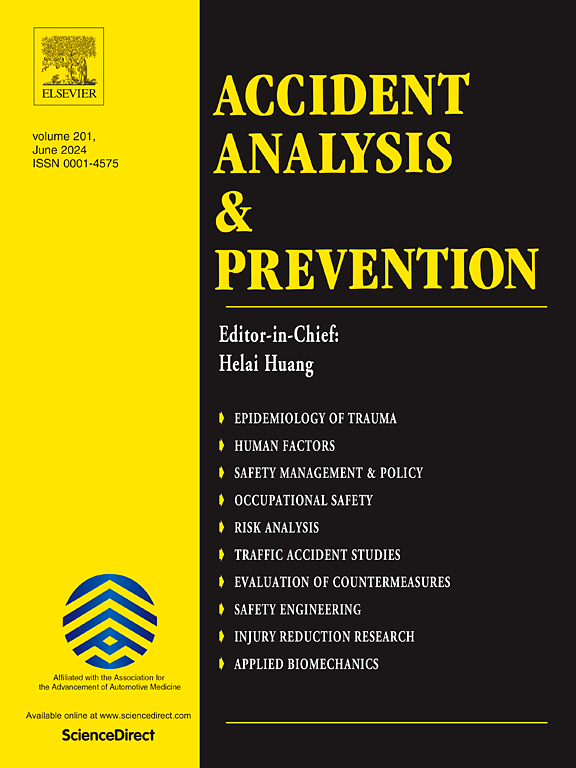自动驾驶汽车测试中关键行人场景的生成
IF 5.7
1区 工程技术
Q1 ERGONOMICS
引用次数: 0
摘要
当前的自动驾驶汽车(AV)测试场景主要集中在自动驾驶汽车与周围车辆之间的交互,很少考虑高风险行人的交互。本文提出了一种生成关键测试场景的方法,专门为行人导向的评估设计。首先,从中国4个城市的12个信号交叉口收集微观交通数据。通过提取同一时空背景下重叠的车辆和行人轨迹数据,建立了车辆-行人交互场景库。其次,采用三阶段自动紧急制动模型模拟自动驾驶汽车的决策和控制过程,取代原始场景库中的车辆代理;此外,应用人工势场法对实时交互风险进行评估,识别高风险场景。然后开发了一个以行人为导向的关键测试场景生成框架,定义了关键的决策变量,如行人和车辆之间的速度差异、相对横向距离和相对纵向距离。设计了一个包含场景暴露频率和交互风险的重要抽样函数来生成关键场景。在此基础上,利用辅助目标函数来指导搜索方向。为了提高计算效率,采用了群优化和洪水填充算法。利用该方法,生成了50个具有高暴露频率和高风险特征的高价值车-人交互测试场景。这些场景包含了多样化和高风险的交互动态,为自动驾驶汽车的高保真行人安全测试提供了强有力的支持。本文章由计算机程序翻译,如有差异,请以英文原文为准。
Generation of critical pedestrian scenarios for autonomous vehicle testing
Current autonomous vehicle (AV) testing scenarios predominantly focus on interactions between AV and surrounding vehicles, with limited consideration given to high-risk pedestrian interactions. This paper presents a method for generating critical test scenarios specifically designed for pedestrian-oriented evaluations. First, microscopic traffic data were collected from 12 signalised intersections in 4 cities across China. By extracting overlapping vehicle and pedestrian trajectory data within the same spatiotemporal context, a vehicle–pedestrian interaction scenario library was created. Second, a three-stage autonomous emergency braking model was used to simulate the decision-making and control processes of AV, replacing the vehicle agency in the original scenario library. In addition, the artificial potential field method was applied to assess real-time interaction risks, enabling the identification of high-risk scenarios. A pedestrian-oriented critical test scenario generation framework was then developed, defining key decision variables such as speed differences, relative lateral distances, and relative longitudinal distances between pedestrians and vehicles. An importance sampling function, incorporating both scenario exposure frequency and interaction risk, was designed to generate critical scenarios. The process was further refined with an auxiliary objective function to guide the search direction. To improve computational efficiency, swarm optimisation and flood-fill algorithms were employed. Using this method, 50 high-value vehicle–pedestrian interaction test scenarios, characterised by high exposure frequency and risk, were generated. These scenarios encompass diverse and high-risk interaction dynamics, providing robust support for high-fidelity pedestrian safety testing of AV.
求助全文
通过发布文献求助,成功后即可免费获取论文全文。
去求助
来源期刊

Accident; analysis and prevention
Multiple-
CiteScore
11.90
自引率
16.90%
发文量
264
审稿时长
48 days
期刊介绍:
Accident Analysis & Prevention provides wide coverage of the general areas relating to accidental injury and damage, including the pre-injury and immediate post-injury phases. Published papers deal with medical, legal, economic, educational, behavioral, theoretical or empirical aspects of transportation accidents, as well as with accidents at other sites. Selected topics within the scope of the Journal may include: studies of human, environmental and vehicular factors influencing the occurrence, type and severity of accidents and injury; the design, implementation and evaluation of countermeasures; biomechanics of impact and human tolerance limits to injury; modelling and statistical analysis of accident data; policy, planning and decision-making in safety.
 求助内容:
求助内容: 应助结果提醒方式:
应助结果提醒方式:


